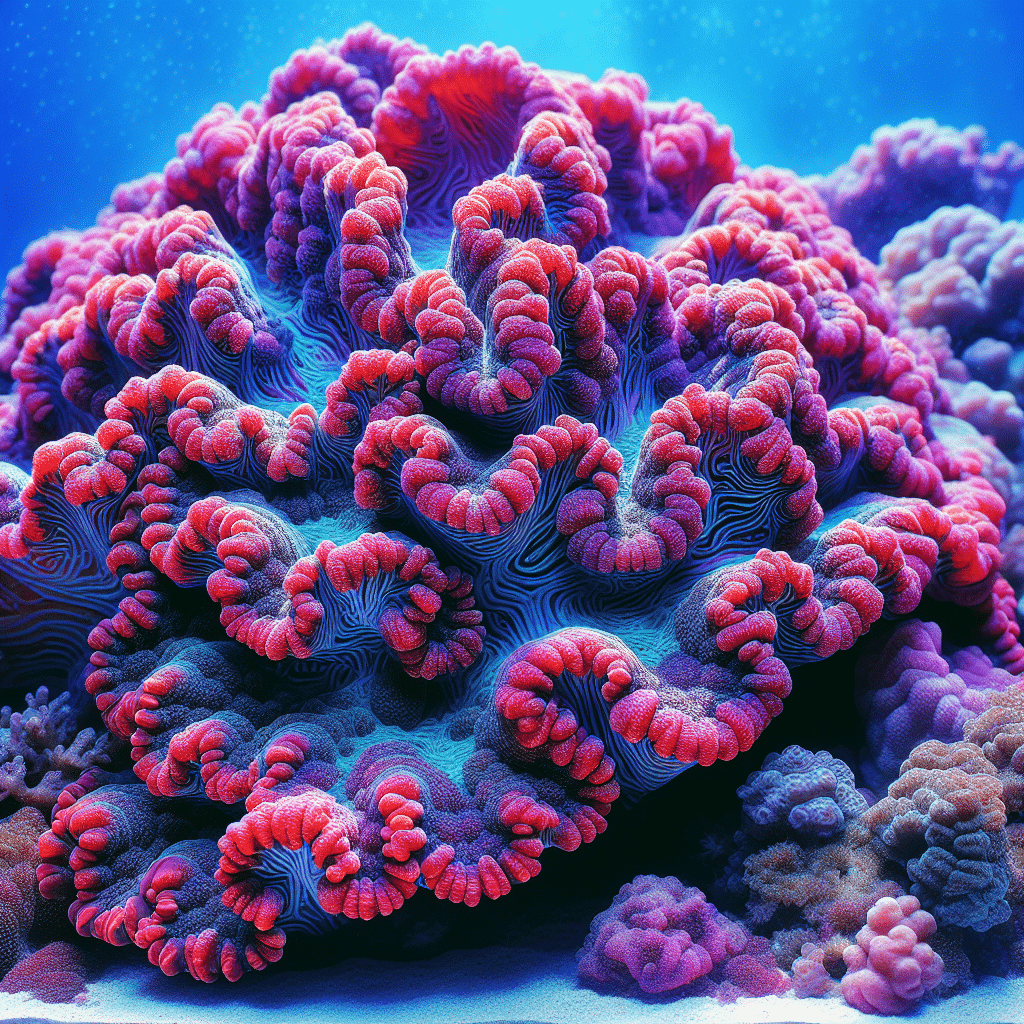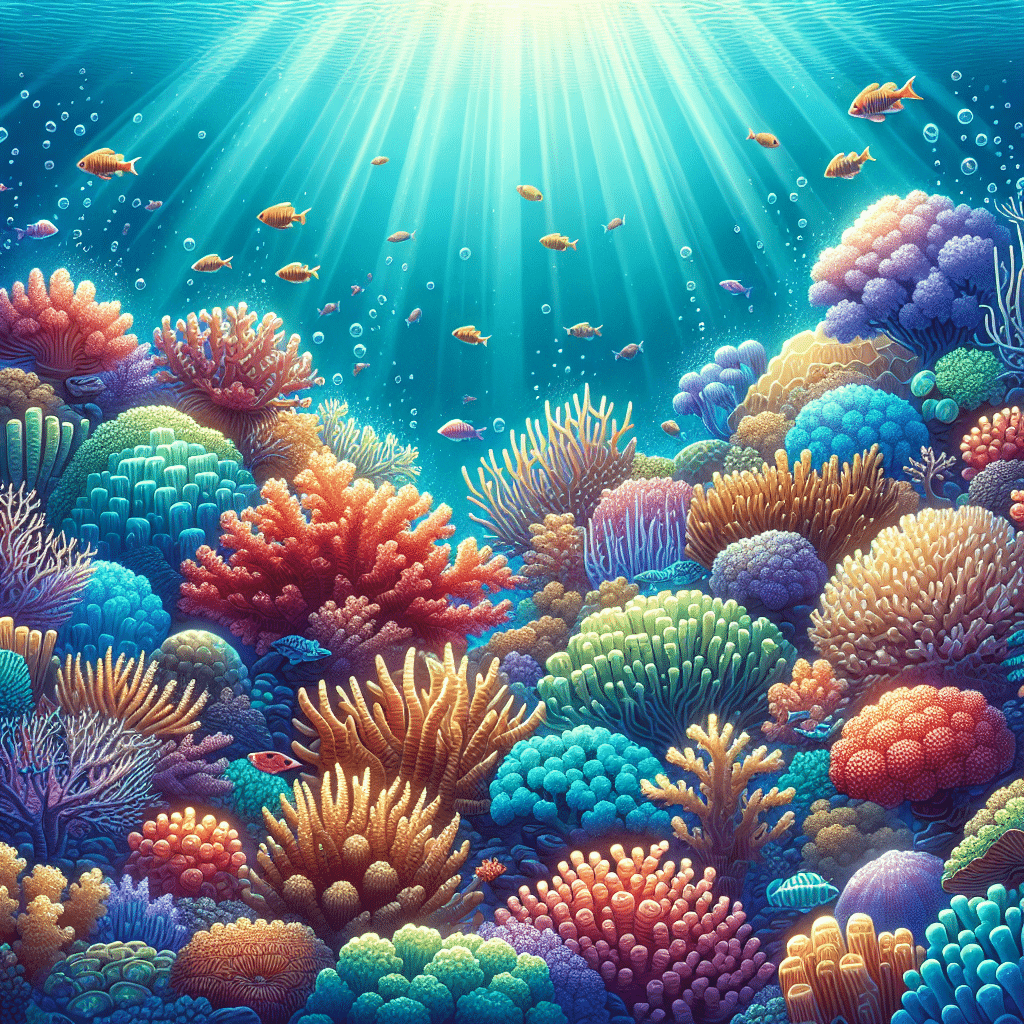Introduction to Acan Corals
Acan Coral Overview
I want to introduce you to Acan corals, scientifically known as Acanthastrea lordhowensis. These vibrant corals are native to regions like Australia, Vietnam, and Indonesia, and belong to the class Anthozoa and the family Mussidae. They are categorized as large polyp stony (LPS) corals, which makes them perfect for those just starting out with coral care. One of the best things about Acan corals is their peaceful nature, although they can get stung by Acan Enchinatas, which is another species in the same family.
Acan corals come in a stunning array of colors, including violet, black, blue, green, red, yellow, and orange, with some even showcasing rainbow morphs. This diversity allows them to add a significant splash of color to any reef aquarium. They thrive in moderate lighting and water flow conditions, making them easier to care for compared to some other coral types.
Acan Coral Habitat
Acan corals can be found in the South Pacific, especially around the Philippines, Papua New Guinea, and Australia, often residing in waters that can reach depths of up to 30 meters (Reef Exclusive). They have adapted to a variety of reef habitats and can grow in almost any environment that provides the right conditions. Generally, they prefer low to medium water flow and low lighting, which makes them suitable for many aquarium setups.
To visualize their preferences better, here’s a quick reference table:
| Habitat Feature | Preference |
|---|---|
| Depth | Up to 30 meters |
| Water Flow | Low to Medium |
| Lighting | Low |
Understanding where Acan corals thrive helps in replicating a suitable environment in your own aquarium. For more information on different types of corals, you can explore our section on corals.
Care Tips for Acan Corals
Caring for Acan corals can be a rewarding experience for any reef tank hobbyist. I’ve learned a few tips along the way that can help keep these beautiful corals thriving in my aquarium.
Ideal Tank Placement
When choosing the best location for Acan corals in your tank, I recommend placing them in areas with low to medium water flow. These corals are native to environments with gentle currents, and they thrive best when not subjected to strong water movement. Additionally, it’s wise to position them on the substrate or on a stable rock base to prevent any potential damage from shifting or falling.
Lighting and Water Flow Needs
Acan corals prefer low lighting conditions, making them a suitable choice for those who may have tanks with less intense illumination. While they can tolerate higher light levels, too much brightness may lead to stress. I’ve found that a good range of about 50 to 100 PAR (Photosynthetically Active Radiation) works well for Acan corals. As for water flow, maintaining a gentle current helps them to feed effectively while preventing any excess debris from accumulating on their surfaces.
| Aspect | Recommendation |
|---|---|
| Lighting | Low (50-100 PAR) |
| Water Flow | Low to Medium |
Feeding Recommendations
Feeding Acan corals is not strictly necessary, but I’ve noticed that providing them with the right nutrients can lead to better coloration and faster growth. Target feeding is key since these corals are nocturnal predators. I usually offer them LPS pellets, minced meaty foods, and zooplankton during the evening hours when they are most active. In optimal conditions, they can sprout new heads every 7-14 days, making feeding an important aspect of their care (Reef Exclusive).
By keeping these care tips in mind, I can ensure that my Acan corals flourish in my reef tank. Whether it’s monitoring their placement, lighting, or feeding, each little detail contributes to their overall health and vibrancy. For more information on different types of corals, check out our articles on brain coral, mushroom coral, and torch coral.
Acan Coral Appearance
Acan corals are well-loved in the reef tank community for their stunning visual appeal. Their vibrant colors and unique growth patterns make them a favorite among hobbyists.
Color Varieties
Acan corals come in an impressive array of colors, ranging from vivid reds and oranges to deep blues and greens. Some unique varieties can even showcase rainbow morphs. Here’s a breakdown of common colors found in Acan corals:
| Color Variety | Description |
|---|---|
| Red | Bright and eye-catching |
| Orange | Warm hues that stand out |
| Violet | Soft, calming shades |
| Black | Bold and dramatic |
| Blue | Rare, often sought after |
| Green | Fresh and lively appearance |
| Multicolored | Combination of multiple colors |
Healthy Acan corals have a fluffy appearance, with their skeleton not exposed. This aesthetic quality is enhanced when they are well-cared for, making them a striking addition to any reef aquarium. They thrive in moderate lighting and moderate to high flow environments, which helps bring out their vibrant colors.
Growth Patterns
Acan corals grow by producing new heads, eventually forming a dome shape as they mature. This characteristic growth pattern not only adds to their beauty but also makes them visually dynamic in a reef tank. Here’s what to know about their growth:
| Growth Stage | Description |
|---|---|
| Young Heads | Individual heads emerging, spaced apart |
| Mature Dome | Heads cluster together, creating a dome |
| Full Growth | Dense formation with multiple heads |
Fragging Acan corals can be challenging, as it involves cutting down on their skeleton between two heads. It’s essential to take care during this process to avoid damaging the coral. Although feeding is not strictly necessary for Acan corals, it is encouraged for better coloration and faster growth. For optimal results, LPS pellets are recommended (Fragbox).
Overall, the appearance of Acan corals, with their diverse color varieties and unique growth patterns, makes them a captivating choice for any reef tank enthusiast. If you’re considering adding corals to your tank, be sure to explore options like brain coral, mushroom coral, and torch coral for additional variety.
Acan Coral Maintenance
Taking care of my Acan corals involves a few essential tasks, including fragging and disease prevention. These steps help ensure my corals thrive in the reef tank environment.
Fragging Acan Corals
Fragging, or propagating, Acan corals is a straightforward process. Acan corals can reproduce both sexually and asexually, and in captivity, I can reproduce them by fragmenting them into multiple pieces. This method allows me to cultivate new colonies without needing to purchase more corals.
To frag my Acan coral, I follow these steps:
- Select a Healthy Coral: I choose a healthy piece of Acan coral to ensure successful propagation.
- Use a Sharp Tool: A sharp knife or coral cutter is essential to make clean cuts without damaging the coral.
- Cut the Coral: I carefully cut the coral into sections, making sure each piece has a good amount of tissue and skeleton.
- Place in Recovery Area: After cutting, I place the frags in a recovery area with low flow and low lighting to help them acclimate.
- Monitor Growth: I keep an eye on my frags to ensure they’re recovering and starting to grow.
For more tips on fragging, I recommend checking out resources on coral propagation.
Disease Prevention
Acan corals are generally hardy, but they can still face challenges. To keep my Acan corals healthy, I take several precautions to prevent diseases:
Stable Water Conditions: Maintaining stable water parameters, such as salinity, pH, and temperature, is crucial. I use a high-quality protein skimmer to help keep my water clean and clear.
Target Feeding: Acan corals are voracious nocturnal predators. I feed them minced mysis shrimp, enriched brine shrimp, and other meaty marine foods for optimal growth (Seahorse Aquariums).
Acclimation Process: When introducing new Acan corals to my tank, I acclimate them slowly. This includes a dip to remove unwanted parasites, bacteria, and protozoans, followed by a period of lowered light intensity to reduce stress.
Keep Distance from Other Corals: I ensure that Acan colonies are at least six inches away from other corals to prevent territorial disputes and potential stinging from their aggressive sweeper tentacles (Boodleshire Aquatics).
By following these maintenance tips, I can ensure that my Acan corals not only survive but thrive in my reef tank. For more information on different coral types and care, check out the other articles on corals.
Acan Coral Species Diversity
Acan corals are fascinating and colorful additions to any reef tank. Within this group, two notable species are Acanthastrea lordhowensis and Micromussa lordhowensis. Let’s dive into what makes each of these species unique.
Acanthastrea Lordhowensis
Acanthastrea lordhowensis, commonly referred to as Acan coral or Acan Lords, is a popular choice among coral enthusiasts. These corals are native to regions like Australia, Vietnam, and Indonesia and belong to the class Anthozoa and family Mussidae. They are classified as Large Polyp Stony (LPS) corals, making them suitable for beginners in coral care.
| Feature | Description |
|---|---|
| Habitat | Australia, Vietnam, Indonesia |
| Lighting | Low to moderate |
| Water Flow | Low to medium |
| Growth Rate | New heads every 7-14 days under optimal conditions |
| Color Varieties | Red, orange, multicolored, violet, blue, green, yellow |
Healthy Acanthastrea corals exhibit a fluffy appearance with no exposed skeleton. They can thrive in various colors, but the most vibrant specimens are often red or orange. When fully grown, they tend to form a dome shape as they produce new heads. Although feeding is not strictly necessary, it is highly encouraged to boost their coloration and growth. I recommend using LPS pellets for the best results. For more information on their care, check out corals.
Micromussa Lordhowensis
Micromussa lordhowensis, another intriguing member of the Acan coral family, is also known for its colorful appearance and peaceful temperament. They thrive in similar environments as Acanthastrea lordhowensis, preferring low to moderate lighting and low to medium water flow.
| Feature | Description |
|---|---|
| Habitat | Similar to Acanthastrea |
| Lighting | Low to moderate |
| Water Flow | Low to medium |
| Color Varieties | Rich in colorful patterns, including rainbow morphs |
Micromussa species are known for their unique color patterns, which can include vibrant hues that range from violet to black, and even variants with rainbow colors. Just like Acanthastrea, they grow by forming new heads and can also benefit from supplemental feeding. They make a great addition to any reef tank and can coexist peacefully with other corals, although some caution is needed as they can be stung by certain species like Acan Enchinatas.
With the diversity of Acan corals, both Acanthastrea lordhowensis and Micromussa lordhowensis offer stunning visual appeal and are relatively easy to care for, making them excellent choices for any coral enthusiast. If you’re curious about coral placement strategies, you can find more tips here.
Acan Coral Compatibility
When it comes to keeping Acan corals in my reef tank, compatibility with other tank mates and proper coral placement are crucial for a thriving aquarium. Here’s what I’ve learned about finding the right companions for my Acan corals and how to position them effectively.
Tankmates for Acan Corals
Acanthastrea corals, commonly known as Acan corals, are typically compatible with a variety of other species in the aquarium. However, they can become aggressive if crowded, leading to territorial disputes or what some hobbyists call “coral warfare” (Aquarium Depot). To prevent this, it’s essential to provide adequate space for them to flourish.
Recommended Tankmates:
| Species Type | Examples |
|---|---|
| Other Soft Corals | Xenia, Mushroom Coral, Leather Coral |
| Stony Corals | Brain Coral, Duncan Coral, Montipora |
| Fish | Clownfish, Gobies, Blennies |
I always keep Acan colonies at least six inches away from other corals to avoid any aggressive confrontations. Acan corals are hardy and can tolerate various conditions, making them a great addition to established reef tanks (Seahorse Aquariums).
Coral Placement Strategies
Placement is key when setting up Acan corals in my tank. Since they are nocturnal feeders and can be aggressive with their sweeper tentacles, careful consideration of their location is necessary.
Placement Tips:
- Avoid Crowding: Maintain at least six inches of space between Acan corals and their neighbors to reduce aggression and stinging risks.
- Lighting Conditions: Acan corals thrive in low to moderate lighting. I make sure to place them in areas where they receive indirect light, which helps prevent stress from high-intensity lighting (Boodleshire Aquatics).
- Water Flow: Acan corals prefer moderate water currents. I position them in spots where they can benefit from gentle flow without being blasted directly by strong currents.
By following these placement strategies and selecting compatible tank mates, I ensure that my Acan corals not only survive but thrive in my reef tank. For more details on coral care, check out our section on corals.
Water Quality for Acan Corals
Importance of Water Quality
Water quality plays a critical role in the health and vitality of Acan corals. These corals thrive in pristine environments, and maintaining optimal water conditions is essential for their growth and survival. Factors such as oxygen levels, temperature, and nutrient balance directly impact the well-being of Acan corals.
Adequate oxygen levels are vital for coral respiration and the metabolic activities of other reef inhabitants. Pollution and excessive nutrient enrichment can deplete oxygen levels, leading to hypoxia, which stresses corals and can ultimately be fatal (Coral Reef Alliance). Poor water quality can also exacerbate the effects of climate change, contributing to elevated temperatures that may cause coral bleaching.
Factors Affecting Coral Growth
Several factors can affect the growth and health of Acan corals. Below are some key elements to consider when managing water quality in your reef tank.
| Factor | Description |
|---|---|
| Oxygen Levels | Essential for respiration; low levels can lead to stress and death. |
| Nutrient Balance | Excess nutrients can cause algal blooms that smother corals. |
| Sedimentation | High sediment loads block sunlight and disrupt feeding and growth. |
| Chemical Pollutants | Heavy metals, pesticides, and oils inhibit growth and reproduction. |
Excessive nutrient inputs from sources like agricultural runoff and sewage discharge can lead to eutrophication, causing rapid algal growth that smothers corals and impedes oxygen exchange (Coral Reef Alliance). Furthermore, increased sedimentation can block sunlight and disrupt coral feeding and reproductive processes.
Chemical pollutants pose a severe risk to the health of Acan corals, inhibiting their growth and disturbing the delicate balance of the reef ecosystem. Maintaining high water quality is essential for protecting these corals from toxic threats and ensuring a flourishing reef environment.
For more information on different types of corals and how to care for them, check out our articles on brain coral, mushroom coral, and torch coral.
Acan Coral Acquisition
Purchasing Acan Corals
When I decide to add Acan corals to my reef tank, I explore a few options to ensure I get healthy specimens. Local fish stores often carry Acan corals, but I also check online retailers for a wider selection. Websites like Seahorse Aquariums offer free next-day delivery on orders over €75, which is a great perk if I’m ordering a few pieces.
It’s important to look for Acan corals that appear vibrant and healthy. I avoid any corals showing signs of stress, such as discoloration or retraction of polyps. I also consider the variety and color patterns available, as Acan corals come in a stunning array of colors like violet, black, blue, green, red, yellow, orange, and even rainbow morphs (Aquarium Depot).
| Key Considerations | Notes |
|---|---|
| Health | Look for vibrant colors and expanded polyps. |
| Variety | Consider different color patterns and morphs. |
| Source | Check local stores and reputable online retailers. |
Acclimating Acan Corals
Once I have my Acan coral at home, acclimation is the next critical step. It’s essential to introduce the coral to my tank gradually to avoid shocking it. I usually follow these steps:
- Float the Bag: I float the sealed bag in the aquarium for about 15-20 minutes to equalize the temperature.
- Gradual Mixing: After floating, I open the bag and slowly mix in some tank water over the next 30-60 minutes. This helps the coral adjust to the water parameters.
- Placement: Once acclimated, I gently place the coral in a low-flow area of the tank to minimize stress. Acan corals thrive in moderate to high flow areas but should not be placed directly in strong currents immediately.
Acan corals are hardy and can tolerate a variety of conditions, but stability is key. I ensure that my tank has stable water parameters and use a quality protein skimmer to maintain water quality. For feeding, I provide minced mysis shrimp and enriched brine shrimp, which they love (Seahorse Aquariums).
By following these steps, I help ensure that my Acan corals adjust well and thrive in their new environment. For more information on caring for different types of corals, check out our sections on brain coral and mushroom coral.



